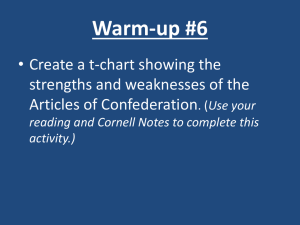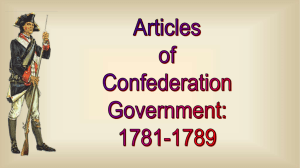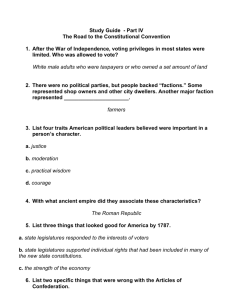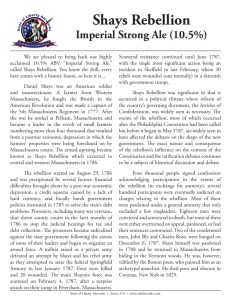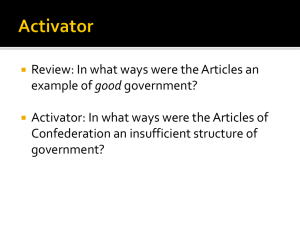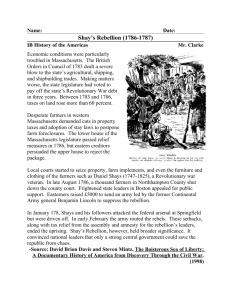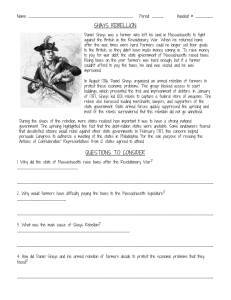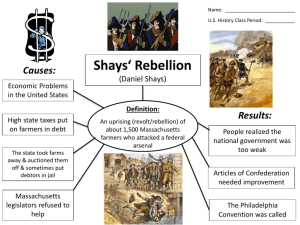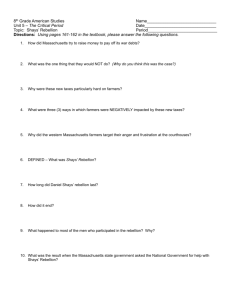Agrarian Unrest and the Constitution
advertisement
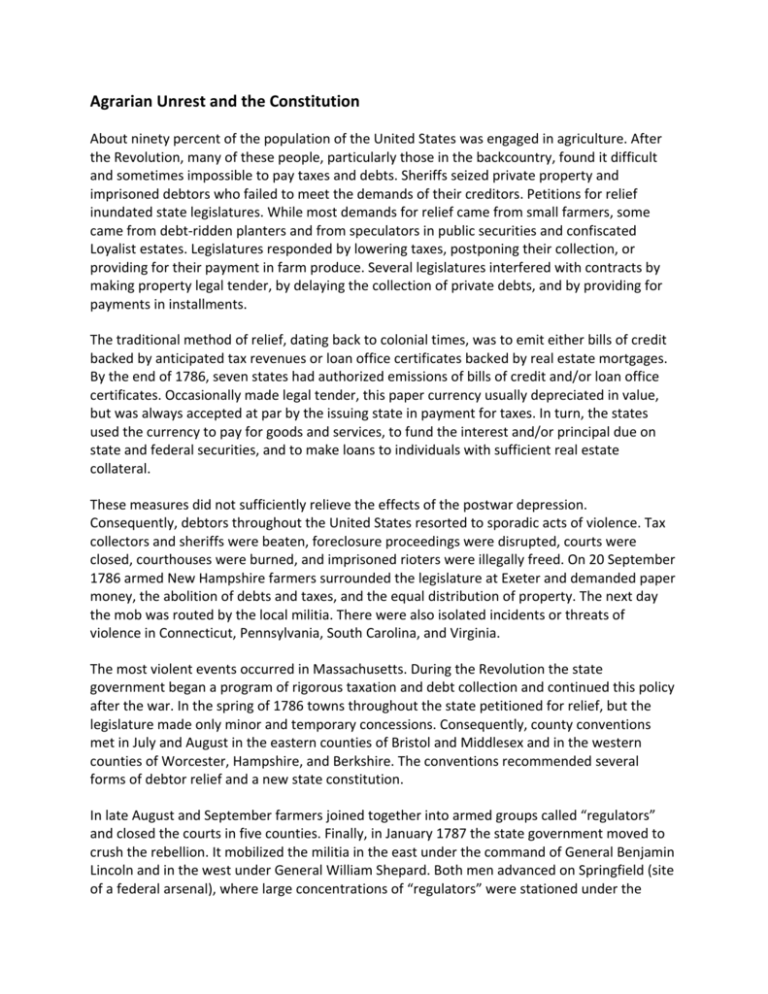
Agrarian Unrest and the Constitution About ninety percent of the population of the United States was engaged in agriculture. After the Revolution, many of these people, particularly those in the backcountry, found it difficult and sometimes impossible to pay taxes and debts. Sheriffs seized private property and imprisoned debtors who failed to meet the demands of their creditors. Petitions for relief inundated state legislatures. While most demands for relief came from small farmers, some came from debt-­‐ridden planters and from speculators in public securities and confiscated Loyalist estates. Legislatures responded by lowering taxes, postponing their collection, or providing for their payment in farm produce. Several legislatures interfered with contracts by making property legal tender, by delaying the collection of private debts, and by providing for payments in installments. The traditional method of relief, dating back to colonial times, was to emit either bills of credit backed by anticipated tax revenues or loan office certificates backed by real estate mortgages. By the end of 1786, seven states had authorized emissions of bills of credit and/or loan office certificates. Occasionally made legal tender, this paper currency usually depreciated in value, but was always accepted at par by the issuing state in payment for taxes. In turn, the states used the currency to pay for goods and services, to fund the interest and/or principal due on state and federal securities, and to make loans to individuals with sufficient real estate collateral. These measures did not sufficiently relieve the effects of the postwar depression. Consequently, debtors throughout the United States resorted to sporadic acts of violence. Tax collectors and sheriffs were beaten, foreclosure proceedings were disrupted, courts were closed, courthouses were burned, and imprisoned rioters were illegally freed. On 20 September 1786 armed New Hampshire farmers surrounded the legislature at Exeter and demanded paper money, the abolition of debts and taxes, and the equal distribution of property. The next day the mob was routed by the local militia. There were also isolated incidents or threats of violence in Connecticut, Pennsylvania, South Carolina, and Virginia. The most violent events occurred in Massachusetts. During the Revolution the state government began a program of rigorous taxation and debt collection and continued this policy after the war. In the spring of 1786 towns throughout the state petitioned for relief, but the legislature made only minor and temporary concessions. Consequently, county conventions met in July and August in the eastern counties of Bristol and Middlesex and in the western counties of Worcester, Hampshire, and Berkshire. The conventions recommended several forms of debtor relief and a new state constitution. In late August and September farmers joined together into armed groups called “regulators” and closed the courts in five counties. Finally, in January 1787 the state government moved to crush the rebellion. It mobilized the militia in the east under the command of General Benjamin Lincoln and in the west under General William Shepard. Both men advanced on Springfield (site of a federal arsenal), where large concentrations of “regulators” were stationed under the leadership of Daniel Shays, Luke Day, Eli Parsons, and Adam Wheeler. In late January Shepard’s forces killed several insurgents near Springfield. Lincoln joined Shepard and together they pursued and routed the insurgents. Many insurgent leaders and their followers escaped across the state border. The upheaval in Massachusetts became known as “Shays’s Rebellion” even though Shays was only one of several leaders, and a reluctant one at that. Moreover, Shays and most of the other leaders insisted that they wanted to obtain relief from the state, not to rebel against it. After the rebellion was crushed, the Massachusetts state government instituted a policy of retribution against the insurgents. In February 1787 Governor James Bowdoin issued a proclamation offering a reward for the capture of rebel leaders. The legislature followed with a disqualifying act which deprived the insurgents of some of their civil rights. By the end of April, about a dozen leaders had been condemned to death and hundreds of rebels had been arrested. Outraged by such harsh policies, the people of Massachusetts voted the Bowdoin administration out of office in April. Two months later the legislature repealed the disqualifying act and pardoned most of the insurgents. Governor John Hancock eventually pardoned everyone; no condemned leader was ever executed. As late as July 1787, small groups of fugitive “regulators” crossed the border and raided in Massachusetts, but they were never a major threat. Nevertheless, the spectre of Shays was kept before the public, and in May and June newspapers were filled with rumors that Shays and his men were planning to attack Massachusetts. In the spring and summer of 1787, newspapers also reported three minor outbreaks of agrarian violence, one in Connecticut and two in Virginia. In each instance, the outbreak was quickly subdued and the leaders were arrested. One of the Virginia leaders was eventually hanged. Shays’s Rebellion had an enormous impact on the attitudes of many Americans. By October 1786 the news of Shays’s Rebellion had spread from one end of America to the other, as newspapers were filled with accounts of the events in Massachusetts. Certain men, such as Henry Knox and Henry Lee, also spread the news, and invariably their accounts were alarmist. On 23 October Knox wrote George Washington that taxes were not the true cause of the rebellion. Knox explained that the “creed” of the insurgents was that the property of the United States “ought to be the common property of all” and that the insurgents were determined “to annihilate all debts public and private, and have agrarian laws, which are easily effected by the means of unfunded paper money, which shall be a tender in all cases whatever.” Knox envisaged “a formidable rebellion against reason, the principle of all government, and against the very name of liberty.” He suggested that the government be “braced, changed, or altered to secure our lives and property.” Influenced by Knox, Henry Lee of Virginia, a member of Congress, informed Washington that “we are all in dire apprehension that a beginning of anarchy with all its calamitys has approached, and have no means to stop the dreadful work.…” He wanted Washington to use his influence and intervene in Massachusetts. Washington’s responses to the news about Massachusetts were fervent. The news was perhaps proof “that mankind when left to themselves are unfit for their own Government.” To Lee’s suggestion that he might be asked to use his influence, Washington retorted that “Influence is no Government. Let us have one by which our lives, liberties and properties will be secured; or let us know the worst at once.” After he received Knox’s letter of 23 October, Washington wrote James Madison that “We are fast verging to anarchy and confusion,” and, he asked, “What stronger evidence can be given of the want of energy in our governments than these disorders?” Washington thanked Knox for his letter which was more satisfactory than the “vague and contradictory” reports of the newspapers. He believed that only a Tory or a Briton could have predicted the disorders in Massachusetts; they were a complete surprise to him. “When this spirit first dawned,” he continued, “probably it might easily have been checked; but it is scarcely within the reach of human ken, at this moment, to say when, where, or how it will end. There are combustibles in every State, which a spark might set fire to” Thus, what was to be feared was not Shays himself, but what he represented. A writer in the Albany Gazette declared that men like Shays existed where government was weak. The “rage of excessive democracy” bred them. In time, some newspaper writers identified anyone who resisted authority or opposed the establishment of a strong central government as a follower of Shays. After the Constitutional Convention adjourned, Shaysite became a Federalist synonym for an opponent of the Constitution. By the end of July, Shays himself was no longer considered a threat, and the newspapers—in at least two widely circulated articles—reflected this change. On 26 July the New York Journal stated: “Poor Shays—little is said of him.” He had become a burden to his friends and they have shunned him. “The rebellion dwindles.…” On 18 August the Pennsylvania Herald noted that “From the Eastward we understand, that the spirit of Shayism rapidly subsides.…” Shays’s Rebellion and other acts of violence thus shocked many Americans who feared that the United States was on the verge of anarchy. Their dismay was heightened by state legislatures which enacted debtor relief or showed leniency toward lawbreakers. Consequently, more and more Americans turned to the idea of a powerful central government—the only kind of government which could restrain the state legislatures and protect life, liberty, and property against the excesses of democracy. In particular, these people looked to the Constitutional Convention for assistance. Cite as: The Documentary History of the Ratification of the Constitution Digital Edition, ed. John P. Kaminski, Gaspare J. Saladino, Richard Leffler, Charles H. Schoenleber and Margaret A. Hogan. Charlottesville: University of Virginia Press, 2009. Canonic URL: http://rotunda.upress.virginia.edu/founders/RNCN-­‐03-­‐13-­‐02-­‐0021 [accessed 11 May 2011] Original source: Commentaries on the Constitution, Volume XIII: Commentaries on the Constitution, No. 1
